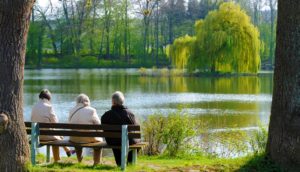Globally, more than 300 million people live with depression, 260 million with anxiety, and many with both. An estimated 6 million American children have been diagnosed with ADHD.
Physical activity is known to to help combat and prevent these disorders, but a walk down a busy traffic-filled street doesn’t cut it. A walk in the woods, however, is different. Just 90 minutes can decrease activity in the subgenual prefrontal cortex — a region associated with rumination (dwelling on negative thoughts, for example).
Perhaps unsurprisingly, exposure to nature can significantly reduce stress. It also alleviates symptoms of anxiety, depression, and ADHD. Spending even a short amount of time in green space can lower blood pressure; it can also help people develop healthier habits and form more positive relationships. People’s mental health is markedly better in urban areas with more green space.
Attention Restoration Theory helps explain why.
Urban environments are overwhelming. City dwellers are constantly bombarded with complex sights, sounds, and smells. Researchers believe that this has a negative effect on executive functioning, making us less able to cope with distractions. Captivating natural scenes, however, can restore attention and help combat mental fatigue.
 Interestingly, some built environments can have the same effect. Cities that incorporate water, or “blue space,” are more restorative than those without.
Interestingly, some built environments can have the same effect. Cities that incorporate water, or “blue space,” are more restorative than those without.
Monasteries and countryside cottages fit the bill because, like nature, they evoke a sense of “being away.”
Museums and art galleries are restorative because they provide an escape from the cacophony of urban life. These scenes all give one a sense of space — of room to explore.
The more interactive we are with restorative space, the better; a weekend stay in a cozy wooded cabin will do more good than staring at a picture of one.
Photos via Adobe Stock.
The above is an excerpt from “Healed By Trees“, an article by Natalie Slivinski in YES! Magazine. Read the full article here.

